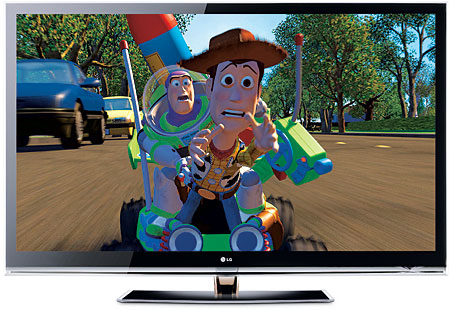Did the reviewer, Thomas J. Norton, see horizontal banding in lighter areas of this set? Many people on line have reported banding visible in lighter areas, especially when the camera pans.
LG Infinia 47LE8500 LCD HDTV
 Price: $2,900 At A Glance: 10-step calibration option • Strikingly deep blacks • Crisp resolution and accurate color • Local-dimming LED technology
Price: $2,900 At A Glance: 10-step calibration option • Strikingly deep blacks • Crisp resolution and accurate color • Local-dimming LED technology
Black Is the Color

Although 3D is about to make a loud buzz in the HDTV world, most current sets aren’t ready for the 3D gravy train yet. The top-of-the-line LG Infinia LX9500 series will be 3D capable. At one step down in LG’s lineup is the solidly 2D Infinia 47LE8500 LCD HDTV, reviewed here. It’s surprisingly thin, and with local-dimming LED technology, it comes well equipped to compete for honors as the best overall LCD we’ve yet seen from any manufacturer.
The Sum of Its Parts
The LG’s inputs and outputs include two USB ports for viewing photos and listening to MP3s stored on an external USB storage device. It also includes a LAN terminal for a wired connection to a home network, and you can buy an optional LG Wi-Fi USB dongle ($80) to make that network link wireless. LG designates an additional input to mate up with another option: LG’s Wireless Media Box. More on the latter a bit further on.
The Quick Menu lets you immediately access some of the more commonly used features. However, to get to all the good stuff, you’ll want to head for the main picture menu. There, you’ll find eight picture modes, including Intelligent Sensor, which automatically adjusts the picture on the fly in response to the room lighting. The set is THX certified and includes two THX modes: THX Cinema and THX Bright Room. Both of these modes have picture settings that are not user adjustable. Only Aspect Ratio, TruMotion, and Local Dimming are accessible.
The two Expert modes provide the widest choice of adjustments. An ISF technician can calibrate, lock, and rename either or both of these modes as either ISF Day or ISF Night. I used the Expert1 mode for this review.
A Picture Wizard menu helps you set up the basic video controls—Black Level (brightness), White Level (contrast), Color, Tint, and Sharpness (the set provides both Vertical and Horizontal Sharpness controls). This wizard is reasonably accurate, but the brightness and contrast settings it suggested were a little high. You’ll need to make a subjective call with the Backlight setting. For more on the basic settings I used, see HT Labs Measures.
TruMotion is LG’s motion-smoothing, 240-hertz frame-interpolation feature. The set operates at a 120-Hz refresh rate and scans the backlight to produce a 240-Hz-like effect. The User option lets you control Judder and Blur separately.
You can reduce the video look that this feature can create on film-based sources if you increase Blur and leave Judder on zero. I checked out this feature, but I didn’t use TruMotion for my review.

With a 24-frame-per-second source (24 fps or 24 Hz), such as 1080p/24 from a Blu-ray, and with TruMotion on, the set generates four interpolated frames for each real frame. This brings the total refresh rate up to the set’s native 120 Hz. With TruMotion off, the set simply repeats the four added frames rather than interpolating them. For 60-fps material (including native 1080p/60 and both SD and HD interlaced sources that are deinterlaced and converted by the set to match its native 1080p resolution), the repeat/interpolation rate is one added frame for each real frame.
The Expert Control menu provides additional adjustments in the Expert modes. Apart from the color adjustments, I avoided most of them. I either left them off or, in the case of Black Level, set it to Low. However, the Gamma control offers three useful settings. I selected 2.2 for the best result. It measured between 2.22 and 2.3, depending on the brightness level.
The LG’s screen is highly reflective. The onboard audio is solidly mediocre—but you do plan to use an external audio system anyway, right? You can’t select inputs directly from the remote, but it’s a well-designed device otherwise. It’s properly backlit, to boot. The onscreen graphic user interface (GUI) is also sensibly designed and easy to navigate.
Color Commentary
LG’s Color Filter control can turn on the red, green, or blue components of the image independently. Together with a basic color test pattern, these should let you set the Color and Tint controls without external color filters, which aren’t very precise. But if you set this control to show any individual color, and then you attempt
to move to the Color or Tint controls to make a change, the filter immediately turns off. You can also make these adjustments in the Picture Wizard.
The Color Temperature control includes Warm, Medium, and Cool settings. You can choose between a typical two-point white-balance calibration (red, green, and blue controls at both the top and bottom of the brightness range) or a more precise 10point calibration, with adjustments at each 10-IRE brightness step.
- Log in or register to post comments




































































